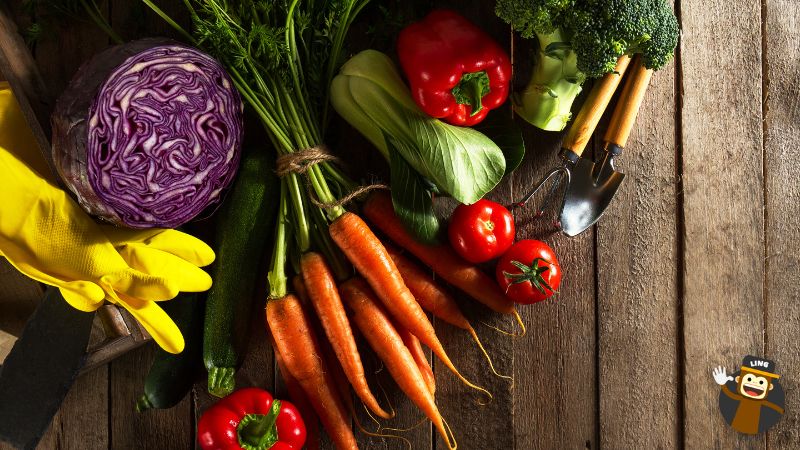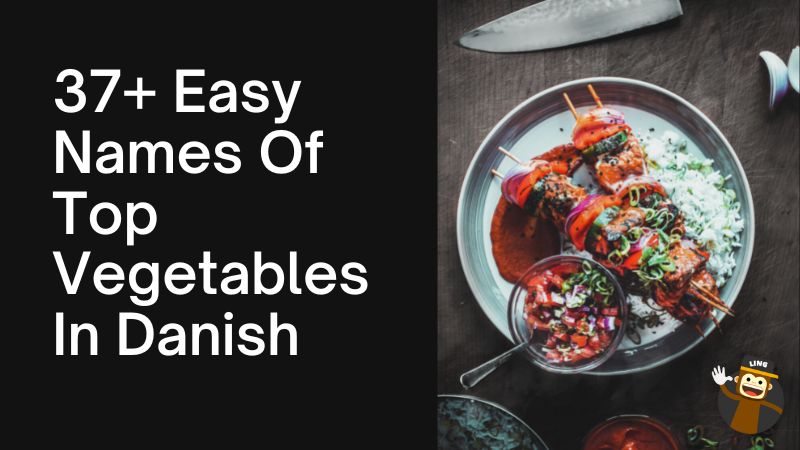Are you wondering what are the easy names of top vegetables in Danish? The most known foods in Danish cuisine are known to use a lot of vegetables as part of their ingredient.
If you go out to Danish restaurants, it is beneficial to know vegetal names, so you can order the sides you want or explain which one you do not wish to have.
Another good reason to learn how to say vegetable names in Danish is to shop at any supermarket in Denmark. Without a basic knowledge of terms related to vegetables can be challenging.
Traditional Danish Foods With Vegetables
Many dishes of the new nordic cuisine include vegetables as part of the main dishes or as part of the sides.
For example, some of the most famous Danish dishes are:
Kartofler
A typical Danish dish with caramelized potatoes is commonly cooked for Christmas eve or lunches. It is a Traditional Danish Christmas food made with boiled potatoes, sugar (or brown sugar), and butter.
Rye Bread
Rye bread is a typical national dish in Denmark and part of the Danish food culture. It is simple to make. The bread crumbs or open sandwich is covered with various toppings, often including vegetables. The rye bread can be black, with sesame seeds, or made in several other ways. There are tons of delicious recipes for making rye bread.
Frikadeller

It is made of pork and served with a side of vegetables, such as cabbage or potatoes. It is possible to use many ingredients to make the meatballs taste differently; for example, they can have a spicy taste.
Potato Salad
It is one of the most famous Danish foods. It is made with boiled potatoes and many savory ingredients, such as boiled eggs, pickles, capers, onions, and parsley sauce.
Stegt Flæsk
This delicious dish is made with pork roast and parsley. People cook the roast pork with halved lemon and sea salt and serve it with a side of vegetables.
Minced Meat With Fried Onion
It is minced beef with onion, served with a side of pea salad, sliced apples, or brown gravy.
Fiskefrikadeller
It is a typical food in Nordic cuisine. It is the same as frikadeller but made with fish instead. Local people serve it with curry sauce (or curry powder).
Mørbradgryde
It is pork tenderloin in a creamy source with fried bacon and mushrooms. It can be served with rice and various vegetables.
Herring Salad
This classic dish consists of herrings, an apple, and onions with a touch of yogurt. Danish people might add other ingredients to the mixture, such as potatoes, vinegar, cream, a special dressing, pickles, veal, beets, carrots, salt and pepper, and even sugar.
Rødgrød Med Fløde (Red Berry Pudding)
Rødgrød med fløde is a traditional Danish food served for dessert with whipped cream.
The ingredients of this must-try dessert are berries, sugar, water, and heavy cream.
If you want a dish to try on your own, this is it! The preparation is super easy. It is made by soaking the berries in sugar and water.
Smørrebrød
Another trendy and famous food is Smørrebrød (open-faced-sandwich). It is made with buttered rye bread topped with meat, cheese, salmon, and variations of dressing and vegetables.
Danish Hash
It is a typical Danish dish that utilizes leftover food. It is made with cooked potatoes, onions, cooked or cold meat, and other toppings to make it taste delicious. Anyone can make their own dish using a variety of vegetables and ingredients.
Since the sea surrounds Denmark, it is common to see a lot of fish dishes in restaurants, but even those, come with vegetables when served. In addition, due to the Danish climate, most foods are cooked and served hot.
Most Easy Names Of Top Vegetables In Danish

The following list includes the most common and easy vegetable names in Danish. You can learn the ones you are most likely to use when shopping or eating in restaurants.
Here are the most common vegetable names in Danish:
- Tomat – Tomato
- Agurk – Cucumber
- Grønkål – Kale
- Bønner – Beans
- Svamp – Mushrooms
- Gulerødder – Carrots
- Kartofler – Potatoes
- Spinat – Spinach
- Majs – Corn
- Selleri – Celery
- Ingefær – Ginger
- Græskar – Pumpkin
- Linser – Lentils
- Hvidløg – Garlic
- Løg – Onion
- Asparges – Asparagus
- Blomkål – Cauliflower
- Rødkål – Red cabbage
- Syltede kapers – Pickled capers
- Porre – Leek
- Kikærter – Chickpeas
- Rabarber – Rhubarb
- Aubergine – Eggplant
- Syltede rødbeder – Pickled beets
- Persille – Parsley
- Salvie – Sage
- Syltede rødbeder – Pickled beetroot
- Stilk – Stalk
- Roe – Turnip
- Rosenkål – Brussel sprouts
- Artiskok – Artichoke
- Byg – Barley
- Urte – Herb
- Mynte – Mint
- Rug – Rye
- Rod – Root
- Syltet agurk – Pickled cucumber
- Grønne bønner – Green beans
- Ærter – Peas
- Forårsløg – Spring onion
- Purløg – Chives
- Kogt kartoffel – Boiled potatoe
- Radise – Radish
- Peberfrugt – Pepper
- Kartoffelmos – Mashed potatoes
Common Danish Idioms With Vegetable Names
A famous Danish chef does not only use vegetables to prepare delicious dishes. But, you might hear vegetable names during a conversation with friends in a way that does not relate to food. In this case, you should suspect that the word is part of an idiom.
Here are some Danish expressions with vegetable names worth knowing:
Here are some Danish expressions with vegetable names worth knowing:
Klare ærterne (Clear the peas)
It means “solve the problem.” Many Danes say it to signify that a problem needs to be solved.
Heldig Kartoffel (Lucky Potato)
It means “lucky person.” You can use this expression to indicate another fortunate person.
Gå Agurk (Go Cucumber)
It is like the English expression ” go bananas.” It means to become very hungry or excited about something. It means going crazy or being extremely enthusiastic.
En Varm Kartoffel (A Hot Potato)
It means that something is a difficult thing to resolve or something you do not want to deal with because it involves the necessity to confront complex problems.
Would you like to know more about the Danish language?
Learn Danish With Ling App!

You can use the Ling App to learn more about Danish culture (not only the popular Danish foods) and become fluent in the language.
Ling is the perfect tool to learn the most challenging parts of a language and things such as grammar, verbs, pronunciation, and more. In addition, the app allows one to learn more than one language.
It is possible to choose between 60 different options. Furthermore, since it is a mobile application, it can be used on the go, with any mobile device, or from the comfort of your home.
Besides, our blog is constantly updating to teach you different essential cultural and language-related topics. Read more articles such as Best Danish Slang Words To Sound Like A Local and apologies in Danish.
Start this fun and efficient experience today. Download from App Store and Play Store for free.








